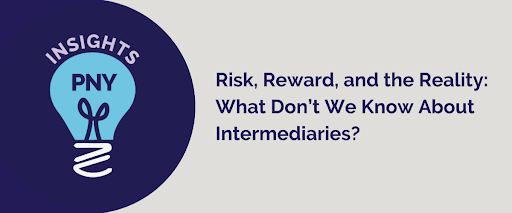Insights from “Risk, Reward, and the Reality: What Don’t We Know About Intermediaries?”
Philanthropic intermediaries play an important role, often serving as a liaison between foundations and nonprofits in re-granting foundation resources and providing important technical assistance and hands-on support to grantees. Although they have been around for decades, their role has been frequently overlooked and largely misunderstood.
As Joy Chia, Executive Director of Astraea Lesbian Foundation for Justice, described, “Intermediaries sit between the source of the money and the final recipients of that funding, but beyond that, there are roles that intermediaries play as channels of information … They are negotiators between parties that have different worldviews or frameworks in which they think about things, but they also have a lot of shared goals and values.”
One of the most important roles for intermediaries is to be a connector. With their hands-on experience and deep relationships, intermediary funders bring a direct connection to on-the-ground movements and play an essential role in moving forward progressive change. In this moment of re-examining our work through a social justice lens, funders can tap into the expertise of intermediaries as part of a strategy for their grantmaking.
In late April, members working within intermediaries as well as private foundations participated in a roundtable discussion. Speakers included NEO Philanthropy’s Rini Chakraborty, Unbound Philanthropy’s Adey Fisseha, and Charles and Lynn Schusterman Family Philanthropies’ Brook Kelly-Green. Moderated by Chia, the panel discussed a number of topics such as the role and risks of intermediaries; approaches, best practices, and lessons of intermediaries; and why it can be strategic for private philanthropy to support them.
Hallmarks of Intermediaries
There is often a distance between funders and the movements they are supporting. This creates challenges in seeing the impacts and potential for social change at the local level. Intermediaries supply deep knowledge and connection to grassroots organizations, which can be helpful for those who may not have staff dedicated to the specific cause they are supporting. However, intermediaries serve not only as a source of insight but so much more for both of the parties that they sit between. They can:
- Provide access to fast, flexible, and consistent funding for grantees
- Act as a buffer to absorb risks for small organizations who might not have the infrastructure to handle certain funding situations
- Activate quick and flexible responses in times of both crisis and opportunity
- Serve as a learning community for funders to gather insights from grantees
Challenges Intermediaries Face
While managing relationships both upwards and downwards between funders and grantees, balancing the needs of both can become tricky, especially when such needs begin to conflict. The roundtable participants outlined these challenges, which can include:
- Uncertain Metrics: The recognition that movement-led strategies for change may be effective, but don’t always fit into neat metrics often required by larger funders
- Operational Budgets: Funding parameters often result in the lowering of administrative expenses for intermediaries, which can greatly affect the efficiency and sustainability of their operations
- Unpredictable environments: There is an expectation to provide multi-year support for grantees. However, maintaining the commitment to grantees to provide consistent support for the long haul can be challenging when there is a desire by larger funders to move on to “whatever is new”
Reflections and Takeaways
As our panel of experts discussed their experiences from both the private foundation and intermediary perspective, they shared some key learnings and reflections:
Mission Creep: For funders, it is important to think through priorities and examine the line between a partnership and the expectation that “high-functioning” intermediaries are capable of taking on any and all new priorities. Keeping communications clear from the outset and maintaining fidelity to your primary funding goals when entering into a relationship with an intermediary will be key.
Hidden Costs: The amount of work that goes into a small grant is essentially similar to that of a larger grant and many of the costs around the infrastructure of intermediaries go unnamed. “It is really important for intermediaries to both be aware of and also to think about solutions to uncompensated and unacknowledged risks that we often ask intermediaries to play,” said Joy Chia. From grantmaking infrastructure, hands-on support, and professional development, to the legal costs inherent to working in “riskier” grantmaking areas, it is important to provide a strong infrastructure to support these hidden costs and for those delving into funding intermediaries, to have a strong grasp of these needs.
Giving up control: Once a funder has decided to support grantees through an intermediary, it is important to recognize that the strategy towards achieving the end goals will be in the hands of others. Brook Kelly-Green from Charles and Lynn Schusterman Family Philanthropies described this dynamic: “Sometimes an intermediary may make a different decision than the one you may make if it was your funding at your foundation ... it makes you concede a little bit of your control, which I think is a necessary and needed practice for all of us in the philanthropic field.”
Watch the full roundtable discussion.



